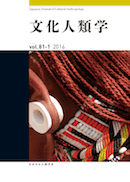Volume 77, Issue 1
Displaying 1-28 of 28 articles from this issue
- |<
- <
- 1
- >
- >|
-
Article type: Cover
2012 Volume 77 Issue 1 Pages Cover1-
Published: June 30, 2012
Released on J-STAGE: April 10, 2017
Download PDF (15284K) -
Article type: Cover
2012 Volume 77 Issue 1 Pages Cover2-
Published: June 30, 2012
Released on J-STAGE: April 10, 2017
Download PDF (15284K) -
Article type: Appendix
2012 Volume 77 Issue 1 Pages App1-
Published: June 30, 2012
Released on J-STAGE: April 10, 2017
Download PDF (73K) -
Article type: Article
2012 Volume 77 Issue 1 Pages 1-26
Published: June 30, 2012
Released on J-STAGE: April 10, 2017
Download PDF (2729K) -
Article type: Article
2012 Volume 77 Issue 1 Pages 27-40
Published: June 30, 2012
Released on J-STAGE: April 10, 2017
Download PDF (1556K) -
Article type: Article
2012 Volume 77 Issue 1 Pages 41-59
Published: June 30, 2012
Released on J-STAGE: April 10, 2017
Download PDF (1950K) -
Article type: Article
2012 Volume 77 Issue 1 Pages 60-83
Published: June 30, 2012
Released on J-STAGE: April 10, 2017
Download PDF (2631K) -
Article type: Article
2012 Volume 77 Issue 1 Pages 84-104
Published: June 30, 2012
Released on J-STAGE: April 10, 2017
Download PDF (2348K) -
Article type: Article
2012 Volume 77 Issue 1 Pages 105-127
Published: June 30, 2012
Released on J-STAGE: April 10, 2017
Download PDF (2389K) -
Article type: Article
2012 Volume 77 Issue 1 Pages 128-143
Published: June 30, 2012
Released on J-STAGE: April 10, 2017
Download PDF (2760K) -
Article type: Article
2012 Volume 77 Issue 1 Pages 144-155
Published: June 30, 2012
Released on J-STAGE: April 10, 2017
Download PDF (1321K) -
Article type: Article
2012 Volume 77 Issue 1 Pages 156-169
Published: June 30, 2012
Released on J-STAGE: April 10, 2017
Download PDF (2506K) -
Article type: Article
2012 Volume 77 Issue 1 Pages 170-172
Published: June 30, 2012
Released on J-STAGE: April 10, 2017
Download PDF (383K) -
Article type: Article
2012 Volume 77 Issue 1 Pages 173-176
Published: June 30, 2012
Released on J-STAGE: April 10, 2017
Download PDF (545K) -
Article type: Article
2012 Volume 77 Issue 1 Pages 176-180
Published: June 30, 2012
Released on J-STAGE: April 10, 2017
Download PDF (699K) -
Article type: Article
2012 Volume 77 Issue 1 Pages 180-183
Published: June 30, 2012
Released on J-STAGE: April 10, 2017
Download PDF (573K) -
Article type: Article
2012 Volume 77 Issue 1 Pages 183-186
Published: June 30, 2012
Released on J-STAGE: April 10, 2017
Download PDF (593K) -
Article type: Article
2012 Volume 77 Issue 1 Pages 187-189
Published: June 30, 2012
Released on J-STAGE: April 10, 2017
Download PDF (450K) -
Article type: Article
2012 Volume 77 Issue 1 Pages 189-193
Published: June 30, 2012
Released on J-STAGE: April 10, 2017
Download PDF (614K) -
Article type: Appendix
2012 Volume 77 Issue 1 Pages 194-198
Published: June 30, 2012
Released on J-STAGE: April 10, 2017
Download PDF (382K) -
Article type: Appendix
2012 Volume 77 Issue 1 Pages 199-201
Published: June 30, 2012
Released on J-STAGE: April 10, 2017
Download PDF (276K) -
Article type: Appendix
2012 Volume 77 Issue 1 Pages 201-
Published: June 30, 2012
Released on J-STAGE: April 10, 2017
Download PDF (75K) -
Article type: Appendix
2012 Volume 77 Issue 1 Pages 202-
Published: June 30, 2012
Released on J-STAGE: April 10, 2017
Download PDF (55K) -
Article type: Appendix
2012 Volume 77 Issue 1 Pages App2-
Published: June 30, 2012
Released on J-STAGE: April 10, 2017
Download PDF (38K) -
Article type: Appendix
2012 Volume 77 Issue 1 Pages App3-
Published: June 30, 2012
Released on J-STAGE: April 10, 2017
Download PDF (38K) -
Article type: Appendix
2012 Volume 77 Issue 1 Pages App4-
Published: June 30, 2012
Released on J-STAGE: April 10, 2017
Download PDF (38K) -
Article type: Cover
2012 Volume 77 Issue 1 Pages Cover3-
Published: June 30, 2012
Released on J-STAGE: April 10, 2017
Download PDF (61K) -
Article type: Cover
2012 Volume 77 Issue 1 Pages Cover4-
Published: June 30, 2012
Released on J-STAGE: April 10, 2017
Download PDF (61K)
- |<
- <
- 1
- >
- >|
